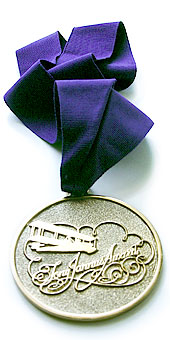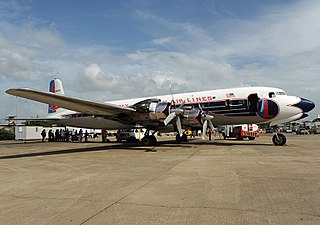
Charlotte Douglas International Airport, typically referred to as Charlotte Douglas, Douglas Airport, or simply CLT, is an international airport in Charlotte, North Carolina, United States, located roughly six miles west of the city's central business district. Charlotte Douglas is the primary airport for commercial and military use in the Charlotte metropolitan area. Operated by the city of Charlotte's aviation department, the airport covers 5,558 acres of land.

The Lockheed Constellation ("Connie") is a propeller-driven, four-engined airliner built by Lockheed Corporation starting in 1943. The Constellation series was the first pressurized-cabin civil airliner series to go into widespread use. Its pressurized cabin enabled commercial passengers to fly well above most bad weather for the first time, thus significantly improving the general safety and ease of air travel.
US Airways was a major airline in the United States that operated from 1937 until 2015, when it merged with American Airlines. It was originally founded in Pittsburgh as a mail delivery airline called All American Aviation, which soon became a commercial passenger airline. In 1953, it was renamed Allegheny Airlines and operated under that name for a quarter-century. In October 1979, after the passage of the Airline Deregulation Act, Allegheny Airlines changed its name to USAir. A decade later it had acquired Piedmont Airlines and Pacific Southwest Airlines (PSA), and was one of the U.S.'s seven transcontinental legacy carriers. In 1997, it rebranded as US Airways.

The NAMC YS-11 is a turboprop airliner designed and built by the Nihon Aircraft Manufacturing Corporation (NAMC), a Japanese consortium. It was the only post-war airliner to be wholly designed and manufactured in Japan until the development of the Mitsubishi SpaceJet during the 2010s, roughly 50 years later.
The Lockheed Model 10 Electra is an American twin-engined, all-metal monoplane airliner developed by the Lockheed Aircraft Corporation, which was produced primarily in the 1930s to compete with the Boeing 247 and Douglas DC-2. The type gained considerable fame as one was flown by Amelia Earhart and Fred Noonan on their ill-fated around-the-world expedition in 1937.

The Douglas DC-4 is an American four-engined (piston), propeller-driven airliner developed by the Douglas Aircraft Company. Military versions of the plane, the C-54 and R5D, served during World War II, in the Berlin Airlift and into the 1960s. From 1945, many civil airlines operated the DC-4 worldwide.
In aviation, a phugoid or fugoid is an aircraft motion in which the vehicle pitches up and climbs, and then pitches down and descends, accompanied by speeding up and slowing down as it goes "downhill" and "uphill". This is one of the basic flight dynamics modes of an aircraft.

Schreiner Airways was a charter, passenger and cargo airline based in the Netherlands.

Air Midwest Flight 5481 was a Beechcraft 1900D on a regularly scheduled passenger flight from Charlotte Douglas International Airport in Charlotte, North Carolina, to Greenville–Spartanburg International Airport in Greer, South Carolina. On the morning of January 8, 2003, the Beechcraft stalled while departing Charlotte Douglas International Airport and crashed into an aircraft hangar, killing all 21 passengers and crew aboard and injuring one person on the ground.

Hickory Regional Airport is three miles (5 km) west of Hickory, in Catawba County, North Carolina. It is owned by the City of Hickory.

The Wings Over the Rockies Air and Space Museum (WOTR) is located on the former Lowry Air Force Base in Denver, Colorado, United States. The museum preserves the history of Lowry AFB's operations from 1938 to 1994 in its collections, archives, and research library.

Piedmont Airlines was an airline in the United States that operated from 1948 to 1989, when it was acquired by and merged into USAir. Its headquarters were at One Piedmont Plaza in Winston-Salem, North Carolina, a building that is now part of Wake Forest University.

The Tony Jannus Award recognizes outstanding individual achievement in scheduled commercial aviation by airline executives, inventors and manufacturers, and government leaders. The award is conferred annually by the Tony Jannus Distinguished Aviation Society and was first bestowed in 1964 in Tampa, Florida, U.S. Its namesake, aviation pioneer Tony Jannus, piloted the inaugural flight of the St. Petersburg–Tampa Airboat Line on January 1, 1914, the first scheduled commercial airline flight in the world using heavier-than-air aircraft. In addition to preserving the legacy of Tony Jannus, the non-profit Society also offers financial assistance to college students pursuing studies in aviation and conducts an annual essay contest for high school students to encourage careers in aviation.
The Japan Airlines Safety Promotion Center is a museum and educational center operated by Japan Airlines to promote airline safety. It is located on the second floor of the Daini Sogo Building on the grounds of Tokyo International Airport in Ota, Tokyo, Japan. The center estimates that its facility is within five minutes walking distance from the Tokyo Monorail Seibijō Station.

US Airways Flight 1549 was a regularly scheduled US Airways flight from New York City, to Charlotte and Seattle, in the United States. On January 15, 2009, the Airbus A320 serving the flight struck a flock of birds shortly after takeoff from LaGuardia, losing all engine power. Given their position in relation to the available airports and their low altitude, pilots Chesley "Sully" Sullenberger and Jeffrey Skiles decided to glide the plane to ditching on the Hudson River off Midtown Manhattan. All 155 people on board were rescued by nearby boats, with only a few serious injuries. The time from the bird strike to the ditching was less than four minutes.

Jeffrey Bruce "Jeff" Skiles is an airline pilot for American Airlines. On January 15, 2009, he became known globally as first officer of US Airways Flight 1549, when he worked together with captain Sully Sullenberger to water land the aircraft on the Hudson River after the plane lost both of its engines. They were widely celebrated as heroes for landing the plane with no loss of life.

Chesley Burnett "Sully" Sullenberger III is a retired American fighter pilot, diplomat, and airline pilot. He is best known for his actions as captain of US Airways Flight 1549. In 2009 he ditched the plane, landing on the Hudson River after both engines were disabled by a bird strike. All 155 people aboard survived. Sullenberger became an outspoken advocate for aviation safety and helped develop new protocols for flight safety. He served as the co-chairman, along with his co-pilot on Flight 1549, Jeffrey Skiles, of the Experimental Aircraft Association (EAA)'s Young Eagles youth introduction-to-aviation program from 2009 to 2013.

The Douglas DC-2 is a 14-passenger, twin-engined airliner that was produced by the American company Douglas Aircraft Company starting in 1934. It competed with the Boeing 247. In 1935, Douglas produced a larger version called the DC-3, which became one of the most successful aircraft in history.

N836D is a former Eastern Air Lines Douglas DC-7B restored to flying condition and previously operated from Miami-Opa Locka Executive Airport, in Opa-locka, Florida. The aircraft's airworthiness certificate expired in June 2013 and it remains at Charlotte Douglas International Airport on static display.


























